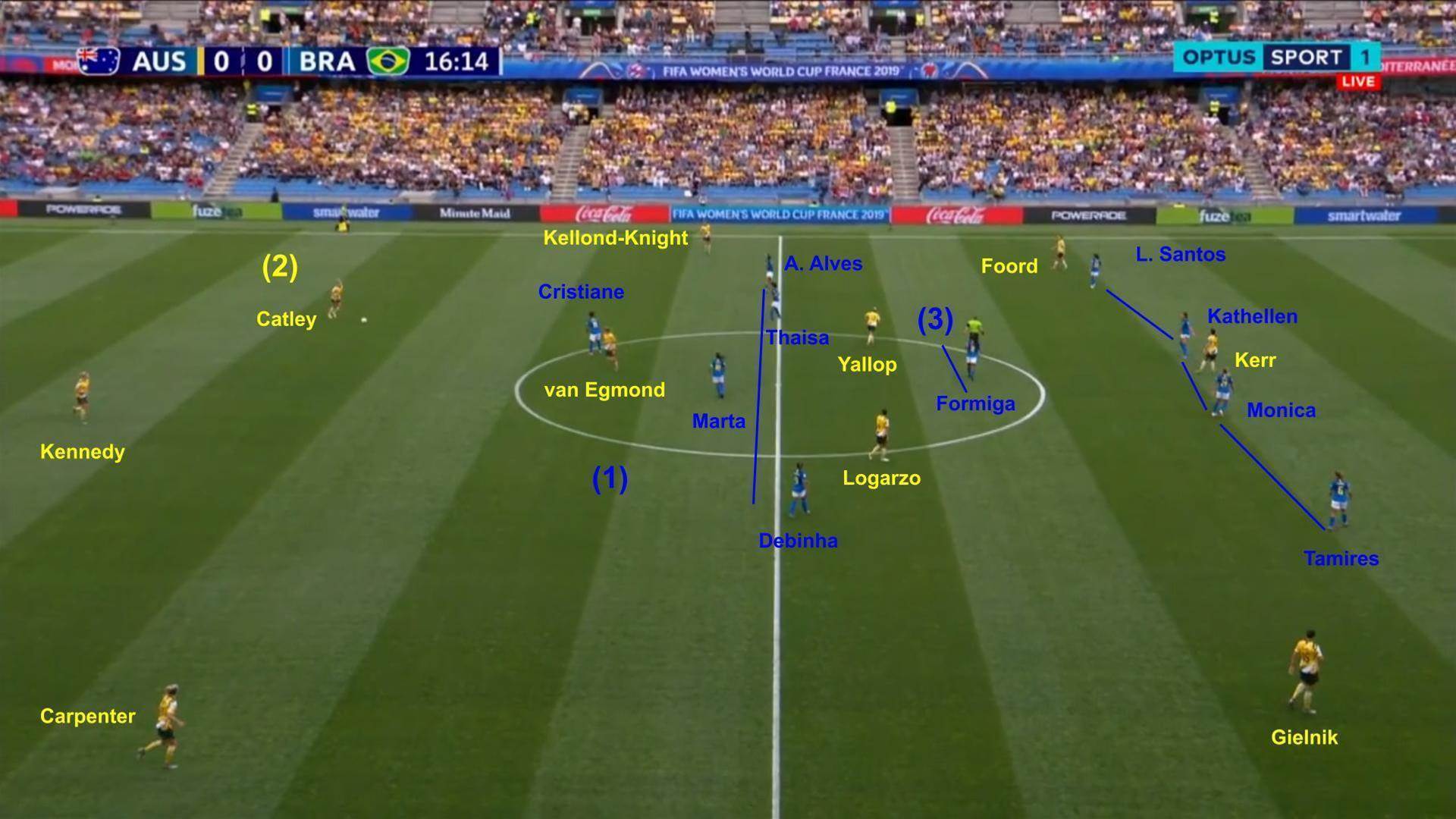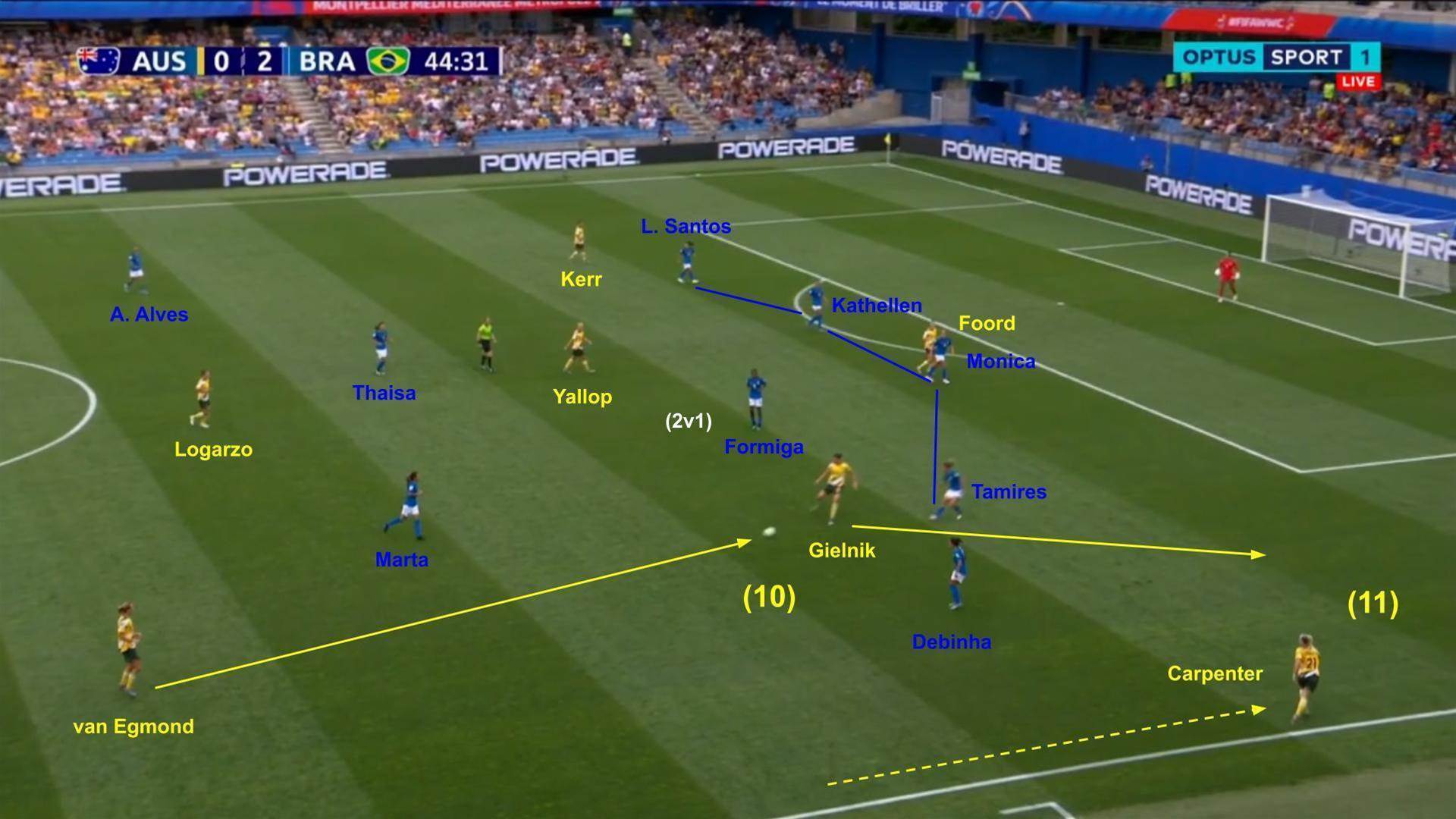Australia entered the tournament thin on options at centreback.
With Clare Polkinghorne ruled out by injury, the main question was who would partner Alanna Kennedy in the centre of defence.
The solution to this was to move left back Steph Catley inside, with midfielder Elise Kellond-Knight taking Catley’s usual role. Otherwise, the rest of Australia’s lineup was as expected against a physical Brazil side, with Emily Gielnik preferred on the right wing.
Brazil meanwhile lined up in a lopsided 4-1-4-1, with left midfielder Debinha moving forward to join lone striker Cristiane in attack when Brazil had possession.
On the opposite flank, Andressa Alves preferred to cut inside on her stronger left foot. This meant that Brazil had a very narrow midfield, and depended heavily on fullbacks Leticia Santos and Tamires to get forward and provide width.
Let’s look at some of the key tactical events.
2v1 against Formiga
Knowing that Australia needed to win to stay in contention to qualify from the group, and wary of the pace of Sam Kerr, Brazil was happy to sit around the halfway line (1) and wait for an Australian error, as shown in the photo below.
Consequently, Australia dominated possession in the opening period, having as much as 69 per cent possession after nine minutes. That being said, possession wasn’t being translated into goalscoring chances, with Australia’s first genuine chance coming from Kerr’s shot in the 36th minute.
 Australia lined up in a 4-3-3, with Tameka Yallop and Chloe Logarzo as the box to box midfielders either side of deep playmaker Emily van Egmond.
Australia lined up in a 4-3-3, with Tameka Yallop and Chloe Logarzo as the box to box midfielders either side of deep playmaker Emily van Egmond.
While Brazil also had three in midfield, only Formiga performed the dirty work of tracking runners; Marta concentrated on creating and Thaisa focused more on blocking passing lanes, for example as shown above, where Catley has the ball (2) but finds a forward pass into Yallop isn’t on.
This frequently left the 41-year-old Formiga outnumbered 2v1 against the relentless running of Yallop and Logarzo (3), which was fine for stopping Australia building through the midfield third but left them at risk of being outnumbered for second balls off a direct pass played into the attacking third.
This was demonstrated for Australia’s first goal, shown below. Here, Logarzo makes a late run into the box off the blindside of Kathellen (4), who is distracted by Kerr’s position (5). Logarzo’s run makes a 2v1 around Yallop’s cross into the box (6), leaving Caitlin Foord free to tap in Logarzo’s flick on (7).

Australia’s high defensive line
In the aftermath of Australia’s opening round defeat to Italy, a large (and arguably unfair) amount of the criticism was centred on the high positioning of the Australian defensive line.
While Polkinghorne and Kennedy’s relative lack of pace meant that they didn’t look entirely comfortable defending with a high line, they were effective at catching the Italians offside on several occasions, and it shouldn’t be forgotten that it was two individual errors of judgement that cost Australia the win.
On the whole, the high line largely worked by allowing Australia to compress the midfield zone in defensive phases, and this continued here against Brazil. As shown in the photo below, the distance between the ball carrier (8) and the defensive line (9) is no more than 20 metres.
 For all their technical gifts, Cristiane, Marta, Andressa Alves, and Debinha aren’t particularly quick, and so it made sense for Australia to risk leaving space in behind for the reward of keeping them far away from goal.
For all their technical gifts, Cristiane, Marta, Andressa Alves, and Debinha aren’t particularly quick, and so it made sense for Australia to risk leaving space in behind for the reward of keeping them far away from goal.
With the quicker Catley at centreback, Australia’s defence also looked much more comfortable holding their line higher, as Catley’s speed allowed her to get across and recover any balls played in behind.
In the second half, Brazil brought on Ludmila, who offered far more pace than Marta (but far less technical quality), and with Catley’s pace Australia were able to keep her quiet.
Carpenter great going forward, but Brazil exploit defensively
Australia’s system relies on their fullbacks Ellie Carpenter and Kellond-Knight to create 2v1 overloads down the wings, working combinations in wide areas with their respective wingers to get into crossing positions.
As against Italy, Carpenter was particularly attack-minded, and her frequent overlapping caused problems for Brazil. For example, in the photo below Gielnik (10) has moved into the space outside of Formiga (similar to how Logarzo and Yallop enjoyed a 2v1 overload) to flick van Egmond’s pass into an overlapping Carpenter (11).
 Carpenter’s strengths in getting forward offset her defensive weaknesses, which in fairness is typical of most young fullbacks in the modern game. While a tenacious defender 1v1, Carpenter’s defensive concentration and positioning can be inconsistent.
Carpenter’s strengths in getting forward offset her defensive weaknesses, which in fairness is typical of most young fullbacks in the modern game. While a tenacious defender 1v1, Carpenter’s defensive concentration and positioning can be inconsistent.
Notably, Brazil attacked more down their left side (i.e. Carpenter’s side), with left back Tamires far more attack-minded than opposite fullback Leticia Santos, and it was Tamires’ cross that led to the penalty for Brazil’s first goal.
For the second goal, Debinha exploited the positioning of Carpenter to run in behind her and cross for Cristiane to score. In this instance, it was Carpenter (and van Egmond) caught ball watching rather than moving to close space.
It’s also interesting to note that in the previous game, Italy also concentrated most of their attacks down Carpenter’s side. Time will tell whether this is because opposition coaches have identified Carpenter’s side as an opportunity, although it is safe to say that the defensive aspects of her game will improve with experience.
Where are Australia’s goals going to come from?
A key concern going into the final game of the group stage is Australia’s struggle to create goalscoring chances. Australia needs to beat Jamaica by a large margin (and even that may not guarantee qualification), it is uncertain where the goals are going to come from.
Australia’s second and third goals against Brazil came from speculative chances that are unlikely to consistently create goals. For the second goal, Logarzo’s cross/shot from distance lacked power, and only went in because Barbara was briefly unsighted at an inopportune moment.
For the third goal, nine times out of ten, Monica’s attempted clearance from van Egmond’s hopeful long ball to Kerr (who was outnumbered 2v1 and therefore unlikely to win the ball) doesn’t result in an own goal. In other words, no coach or team plans to consistently score like this.
Against Italy and Brazil, Australia’s plan was to play high crosses for Kerr and runners from midfield to attack. The penalty against Italy and the first goal against Brazil came from a high cross.
However, statistics show that high crosses are a particularly inefficient strategy, as it places great emphasis on the quality of the delivery to reduce the handling advantage of the goalkeeper and the numerical advantage of the centrebacks.
Unfortunately, as we’ve seen, Australia’s crossing quality has been inconsistent. If Polkinghorne remains unavailable and Catley continues at centreback, this deprives Australia of her crossing ability from the left flank. Simply put, Catley’s crossing is superior to Kellond-Knight’s.
If Australia were to persist with a crossing approach, a more viable strategy would be to play low crosses. It’s easier to play an accurate pass on the ground, and consequently is a much easier ball for a first time shot compared to a ball put into an aerial contest.
Low cutbacks are played into midfield runners (e.g. Yallop and Logarzo) are even better, as this takes the opposition defenders out of the equation.
This Australian squad is, on paper, capable of a big win and going deep into the World Cup. We’ll find out soon enough if they can execute on the field.
The author is an experienced football coach, having coached over 200 games at development and senior level. He has completed the FFA/AFC B Licence and runs the Facebook page "Tacticology", covering the NPLW Victoria.
Related Articles

'Timing not right': Montemurro's verdict on Matildas vacancy

Matildas: 'Fourth at the Olympics is honestly the worst place you could come'
.jpg&h=172&w=306&c=1&s=1)












